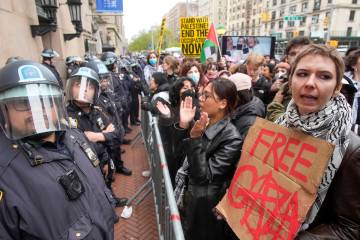Fatal shooting by Henderson police raises questions about volatile situations
Zyber Selimaj knows his emotions tend to get the better of him. So if he had it to do over, this time he would react differently.
He wouldn't break down in tears like he did when Henderson police pulled him over for his second speeding ticket in one day as he made his rounds in his ice cream truck. The Albanian immigrant wouldn't call his wife, Deshira, to help him protest. He would simply sign the citation and go on his way.
Instead, just minutes after he summoned her to the traffic stop, near Coronado High School on Feb. 12, 2008, she was shot and killed by a Henderson police officer after she brandished a knife.
Nearly four years later, Zyber's life — and that of the couple's three sons — has unraveled.
"I am now father and mother to them," he said. "I lost my heart. I lost my wife. There is no medicine for that."
The Henderson Police Department undoubtedly would like a do-over, too, and not just because of the public outcry over one of the most controversial police shootings in Southern Nevada history, or the $700,000 wrongful death settlement paid to the widower.
Jutta Chambers, who became police chief six months after the shooting, said she feels for the Selimaj children, two of whom saw their mother's death, but her officers did what they were trained to do when confronted with an unstable and armed person.
The shooting did, however, spur departmental reforms to help officers handle volatile situations and to be more accountable for the use of deadly force. The reforms cover everything from training and equipment to post-shooting outreach, both to families of those shot and to the officers.
A QUICK ESCALATION
Many officer-involved shootings start in mundane ways, and so it was with this one.
When Zyber was pulled over the second time that February day , he pleaded with officer Patrick Gilmore that he couldn't afford another ticket, and said he just wanted to die.
He refused to sign the citation, and Gilmore let him phone his wife. She arrived a short time later with their oldest and youngest sons, then 11 and 5, in the ice cream truck she operated.
Deshira, 42, became equally emotional and similarly commented about wanting to die. There's not much of an Albanian community in Clark County, so it's no surprise that officers would mistake a common Albanian figure of speech for a suicide threat.
Thinking he had two unstable people on his hands, Gilmore called for backup.
His concerns were validated when Deshira got out of her truck with her sons and a kitchen knife with a 4.5-inch blade. In the next few minutes, she repeatedly threatened to kill herself, her sons or police officers. Soon, 10 officers had arrived at the scene, including Luke Morrison, 23, an Iraq War veteran on the force for two years.
Several passing motorists saw the drama unfold and offered different stories or opinions.
One witness said Deshira was "screaming and hollering" and looked like a "raving lunatic" as she scolded police. Another said she "would have been an easy target to wrestle to the ground," even with a knife in her hand.
The police officers would later say they worried most for the safety of the Selimaj children. But when the two boys were able to walk away from their mother, seemingly out of harm's way, the dynamics shifted again.
The question became whether an irate Deshira and her knife posed a threat to officers.
Still unsure of her intent, officer Anthony Pecorella tried to incapacitate her with a stun gun, but one of the two probes missed. Officers said she then lunged at Pecorella, which prompted Morrison to fire his .40-caliber handgun once.
"There was nothing else anybody could have done," Morrison later said of his decision to shoot.
Chambers agreed: "Luke Morrison did what he had to do. He was put in a horrible situation, and I feel very bad for him that he had to go through that."
After the shooting, Zyber Selimaj was charged with obstructing police.
VERY DIFFERENT PICTURES
The Selimaj shooting received far more scrutiny than most. Part of the public outcry was a result of the perception that police did not need to use deadly force to subdue a middle-aged, modestly sized woman, regardless of her behavior. Then there was the story of the Selimajes.
Advocates portrayed them as hard-working immigrants who came to the United States to pursue the American dream. What could be more American than the chimes of the ice cream trucks both drove through the streets of Henderson?
Zyber spoke of spending two decades as a political prisoner in communist Albania, dreaming the whole time of coming to the United States to live in freedom.
The Henderson Police Department painted a different picture, recounting past domestic disturbance calls at their home. They said Deshira spent a month in a psychiatric facility not long before the shooting, and they dug up two reported altercations between Zyber and children at his ice cream truck. He pleaded no contest to misdemeanor battery stemming from one.
In short, police said, Zyber was a hothead and a troublemaker. And Deshira? She was plain crazy.
Lost in the back-and-forth were important questions: Would things have gone differently if Henderson police, like many other departments, used crisis intervention officers trained to defuse tense encounters? What if the officers had a beanbag shotgun as well as stun guns? And most fundamentally, what is the most effective way for officers to gauge whether lives are in jeopardy?
At the coroner's inquest, officers testified Morrison fired only after Deshira lunged at Pecorella. But a reconstruction of the incident strongly suggested that she was in a crouching position when Morrison shot her. Did that mean she posed little threat, or that she was poised to spring at Pecorella? The answer remains in dispute.
An inquest jury unanimously ruled the shooting justified. Zyber filed a federal lawsuit, which Henderson settled for $700,000 — the largest known payment stemming from a fatal police shooting in Southern Nevada.
Much has changed for Morrison, too, since the shooting. About 18 months later, he left the department amid allegations of a sexual relationship with an underage sister-in-law. No criminal charges were filed. Since the inquest, he's never spoken publicly about the shooting or its aftermath.
SELF-EVALUATION
Police officers have a lot of leeway when it comes to deadly force. But just because a shooting is legal doesn't mean it is necessary. In theory, every officer-involved shooting gives police a chance to evaluate practices that might prevent others.
While the Metropolitan Police Department has had hundreds of shootings since 1990 , Henderson didn't have a real opportunity to critique its policies and procedures until the death of Deshira Selimaj.
Chambers refers to the whirlwind that surrounded that shooting as the department's "Selimaj Era." She said the department used the experience to assess every aspect of the deadly force issue: "We've had to rethink the whole process. And the reason for that is we need to be very self-critical."
Among the changes she has overseen:
■ Training more officers in crisis intervention to make them better able to deal with mentally ill people. Half of those shot by Henderson police since 1990 were having some mental health crisis, more than three times the Metropolitan Police Department's rate during that period.
■ Establishing a Police Action Review Committee to examine training, equipment, and possible disciplinary issues stemming from all critical incidents, including shootings.
■ Eliminating a requirement that officers had to go through their chain of command to make follow-up visits with a psychologist after a shooting.
■ Offering family of shooting subjects an in-person presentation of investigative findings as a way to eliminate any "sense of conspiracy" before an inquest.
Chambers wants her community to have faith in its officers, and her officers to have faith in themselves. Every critical incident, especially an officer-involved shooting, presents challenges and opportunities, she said.
"Our officers have to be prepared for what we hope never happens, and normally never does happen," Chambers said. "We've brought all the officers together who have been involved in an officer-involved shooting and asked them what we as a department could do better. We also want the community to have as much information as possible, so it doesn't appear that we're hiding anything."
LITTLE SOLACE
None of those police department changes do much for Zyber Selimaj, of course.
He lives with his three sons — 15, 11, and 9 — in a home he bought after the settlement. He still drives his ice cream truck a couple days a week, and said that he still frequently gets pulled over by police.
Nearing 70, he remarried last year, to a family friend from Albania who he hoped would help raise his children. But after three weeks with him, she made a domestic violence call to police. Selimaj went to jail; she left Las Vegas.
Based on that complaint, child welfare workers took away his sons for several months. The boys were returned to him this spring, but he still goes back and forth to hearings at which he must convince a judge he can adequately care for them.
He isn't sure where he wants to raise his sons if he is allowed to keep them.
"They cry every day missing their mother," he said. "I don't want to stay here, but where am I going to go?"
Earlier this year, at his sons' urging, Selimaj bought seven pet birds. In what he interprets as a metaphor for what has become of his life, six of the birds died, and one flew away.
"It's free," he said of the escaped animal. "I will never be free."
Alan Maimon is a Review-Journal special correspondent.
Read the full report




























